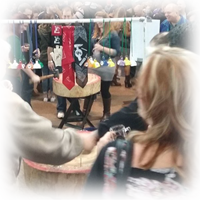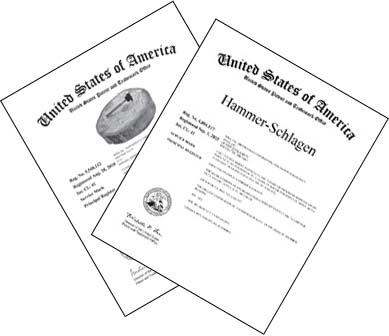

Hammer-Schlagen® is the source and origin of a unique service, and we offer it under many elements of our Hammer-Schlagen® brand. Just like any other well known brand, there exist untrue rumors. Here are some of the most common misconceptions.
| Myth 1: | Different Name |
|---|---|
| Myth 2: | German Word |
| Myth 3: | Hyphen |
| Myth 4: | Oktoberfest Origin |
| Myth 5: | Played In Germany |
| Myth 6: | Third Party Use |
| Myth 7: | Trade Dress |
| Myth 8: | Trademark Disclaimer |
Myth #1: Different Name. All I have to do is change the name, and I can continue to use your trade dress.
The law may prohibit you from engaging in an entertainment service similar to our own and under our trade dress. It doesn't matter what you call the service if you use our primary trademark. Doing this is a very destructive act, because you are affiliating a name with our primary trademark that we do not endorse (called "dilution"). Dilution is an infringement separate and disctinct from counterfeiting our trade dress, so you could be committing two separate acts of trademark infringment if you do this.
Keep in mind that anyone can engage in a nail driving competition so long as it isn't called Hammer-Schlagen® or looks/feels like Hammer-Schlagen®. For more information about what constitutes Hammer-Schlagen® trade dress, see this free legal advice and the trade dress question below.
Myth #2: German Word. Hammerschlagen is a German word that is specific to the service you offer.

The German word "Hammerschlagen" is not specific to the service we offer when used in a German sentence. When translated from German, "Hammerschlagen" means to "beat with a hammer." For example, "Sie Hammerschlagen meine Daumen" translates, roughly, into "you are hitting my thumb with a hammer." (We know that the compound German word "hammerschlagen" is not specific to our brand of nail driving: see, for example, this Yearbook of Literature from 1834 using the compound to describe straightening wire with a hammer during a manufacturing process. On page 368 of Altpreussische Monatsschrift ("Old Prussian Monthly") published in 1874, the compound word is used to describe a pot identifiable by hammer blows seen on its bottom.)
However, the usage of "Hammer-Schlagen®" in the United States does indicate source and origin in us. Even if we could find evidence that the German word "Hammerschlagen" was specific only to our service in a foreign country, we claim ownership rights by way of our registration filings with the United States Patent & Trademark Office.
Myth #3: Hyphen. "Hammer-Schlagen" and "hammerschlagen" are different because one has a hyphen and/or capital letters whereas the other does not.

The formal Hammer-Schlagen® servicemark is the properly spelled and punctuated trademark that we use and operate under. Anything that is confusingly similar invokes the same sense of source and origin of appearance, sound, meaning, and commercial impression under the sight-sound-meaning test described by the USPTO[1][2]. We, therefore, claim ownership of anything that looks similar, sounds similar, has a similar meaning, or is any combination of these three elements not just in our Hammer-Schlagen® mark, but in each and every element of brand.
Myth #4: Oktoberfest Origin. Hammer-Schlagen® dates back to at least 18 October 1810 when the Oktoberfest was first held.

For those who don't know, the marriage of Crown Prince Ludwig (later King Ludwig I) and Princess Therese of Saxe-Hildburghausen occurred on this date. In commemoration of their marriage, a great horse race was organized in Bavaria each year on their anniversary, which later became the Oktoberfest. We believe the claim that our service was offered under any element of our Hammer-Schlagen® brand at this royal wedding or at any of the subsequent horse races is erroneous. As of today, we can find absolutely no evidence to support this claim. We can only assume that this falsehood originates from the fact that Hammer-Schlagen®'s owners (as well as our predecessors) are of nearly full-blooded German decent. Furthermore, Hammer-Schlagen® has engaged in business with many Oktoberfests throughout the United States since our founding which may have also aided in the formulation of this false claim.
Our research indicates that the first time the claim of Hammer-Schlagen® being a German game was in 2005 by Wikipedia[3], and the first time the claim of an Oktoberfest origin was made was by Wikipedia in 2012[4]. (Please take very careful notice that Wikipedia has been unable to verify either of these claims, both were removed by MelanieN of Wikipedia, and the article propgating the false information has since deleted.)
Myth #5: Played In Germany. People do this exact same thing in Bavaria. They even use the same kind of wood. And, the name this service is actually called Nagelspiel.

Our research indicates that the foreign concept of children pounding a single nail into the dirt with an axe, though similar, is not the same and does not use any elements of our brand. Also, recent engagements of our service under our brand overseas does not predate our usage. It is very important to note that our trade dress uses materials that are not available in Germany. One example is plains cottonwood (populus sargentii), Minnesota's most massive tree standing over 100 feet and attaining ages of over a century. (A plains cottonwood tree is a willow native to the Upper Midwest of the United States and not known to exist anywhere in Germany, let alone Europe.)
Yes, that is correct that there is a German-born play-thing called Nagelspiel, but it is a mass-produced childrens' wooden toy (now manufactured in multipule series by Haba) dating to the 1950's and not a service similar to our own. (The literal translation of the Germanic compound word "Nagelspiel" is something along the lines of "to play with nails" or "nail game.")
Myth #6: Third Party Use. Other people use elements of your Hammer-Schlagen® brand, so that means anyone can.

Anyone can pound in a nail. But, if our service is engaged under any element of our brand (including our trade dress), it is communicated to the public that the nail pounding service is Hammer-Schlagen®. We take the theft of our identity to be quite a serious matter, and pursue infringements that become known to us. Some entities unknowingly infringe upon our brand after engaging in our service with us or one of our licensees. In the overwhelming majority of such cases, we grant licensure to the infringing entities so they may continue to operate without the risk of litigation with us.
We are of the opinion that the majority of entities engaging in commerce under one or more element of our Hammer-Schlagen® brand are doing so under licensure from us. We take issue with any entity who knowingly steals Hammer-Schlagen®'s identity. If you are infringing upon our Hammer-Schlagen® brand, you are hereby put on notice to cease and desist your infringements until you obtain a franchise!
Myth #7: Trade Dress. Your trade dress is functional, and therefore you cannot protect it. Even if you could protect it, the definition of your trade dress is so narrow that I only have to change one or two things to escape your trade dress rights.
This is another common misconception. In the eyes of the law, there are two types of "functionality"[5][6]. The first is called "de facto" functionality, which means the item performs the function that it was intended to perform. Wood performs the function of holding the nail in place; nails perform the function of being struck; and a hammer provides the function of doing the striking. This, however, does not make the wood's, nail's, or hammer's shape "functional" for trade dress purposes because those features are not necessary for the wood, nail, or hammer to do its job when these particular designs and shapes are considered as a whole. As the federal circut court states, "De facto functionality simply means that a design has a function ... Such functionality is irrelevant to the question of whether a mark as a whole is functional so as to be ineligible for trademark protection."[7]
The second kind is called "de jure" functionality, which means that competitors must use it in order to compete effectively. Suppose someone pounded hot-coated finishing nails into an 8-foot long 6"x6" laid on the ground with a long-handled fat-head framing hammer. It is doubtful that the public would immediately confuse this get-up with our trade dress. In reality, there are many alternatives to our brand of the service, such as: the competition put on by NFBA; that which is found at the Steele County Fair (we believe this competition may predate our brand[8]); the competition by CPGworks; that at the Berlin County Fair; and the competition at the Brookston Apple Popcorn Festival. The look and feel of our legitimate competitors are not confused as our brand of the service. As this demonstrates, our circular wood, common bright nail, and cross-peen hammer are not "de jure" functional when considered together: none are essential to the use or purpose of pounding a nail into a piece of wood or the cost or quality of partaking in the service. (We believe it is more dangerous and costly--both in time and money--to create our trade dress than it is to counterfeit the look-and-feel of our legitimate competitors.)
The Coke bottle is a great example of trade dress. It performs the de facto function of holding and pouring liquid, but it's look and feel are not connected to the actual holding and pouring of the liquid. In the same manner, the shapes and designs of our trade dress are not connected to the actual nail driving service: these shapes and designs are primarily used to make the nail driving service unique and easy to identify. (Note that our trade dress is an element of our Hammer-Schlagen® brand. When this three-dimensional configuration of shapes and designs is displayed, it is communicated to the public that the nail pounding service is Hammer-Schlagen®. This is also true for anything that is confusingly similar.)
Myth #8: Trademark Disclaimer. One of your trademark registrations with the United States Patent & Trademark Office states that no claim is made to the exclusive right to use "HAMMER SCHLAGEN," so you cannot use Hammer-Schlagen® as your trademark.

The German word "hammerschlagen," when translated, means to strike or beat something with a hammer ("Sie Hammerschlagen meine Finger" in German roughly translates to "you are beating my finger with a hammer" in English). On 21 March 2000, the USPTO suggested that "striking with a hammer" immediately describes our service. As a condition of registering our logo for federal protection, the USPTO required us to make the disclaimer that "No claim is made to the exlusive right to use 'HAMMER SCHLAGEN', apart from the mark as shown." However, this did not bar us from claiming the phrase Hammer-Schlagen® as our trademark: afterall, we do own the federal filing that protects it.
If you have any credible evidence to dispute what we have on this page which may support any of these falsehoods, you are invited to submit your evidence to Hammer-Schlagen® for our most eager review!
